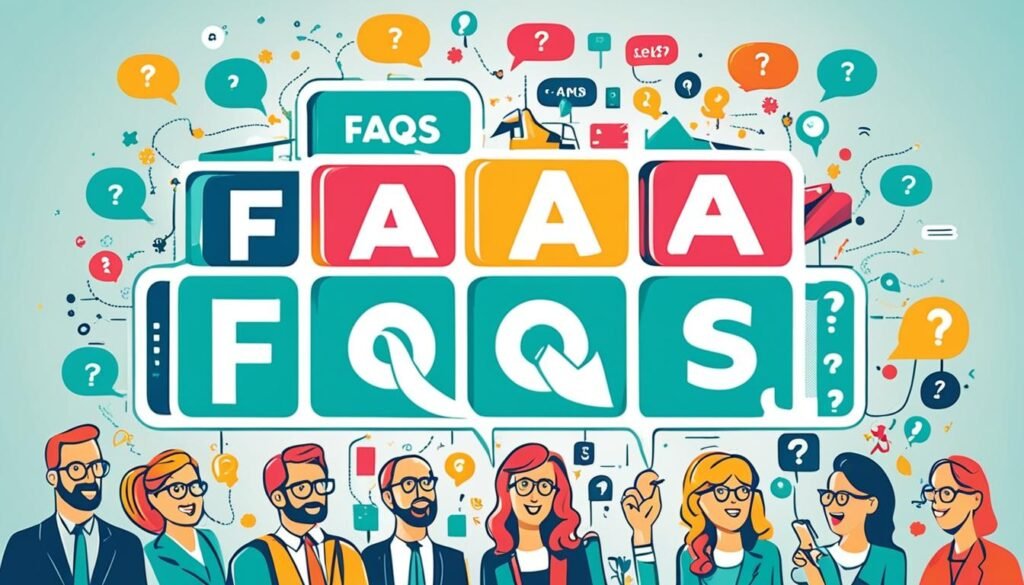Did you know FAQs go way back to 1648? Matthew Hopkins’ “The Discovery of Witches” first used them1. Now, FAQs are key for websites and online groups. They help users quickly find answers to their questions.
FAQs are great for getting support, solving common problems, or just learning more about a topic. They offer a quick way to get the info you need. Whether it’s fixing tech issues or understanding a service, FAQs are a must-have for everyone.
Key Takeaways
- FAQs provide a centralized hub for common questions and concerns, enabling self-service and reducing the burden on customer support teams.
- The FAQ format has evolved from its origins in the 17th century to become a widely adopted tool for organizing and disseminating information on the internet.
- FAQs can improve website navigation, enhance search engine optimization (SEO), and foster trust with customers by addressing their pain points.
- Effective FAQs are organized, concise, and tailored to the specific needs and queries of the target audience.
- Regular updates and optimizations are crucial to ensure FAQs remain relevant and valuable for users.
The Origins of Frequently Asked Questions (FAQs)
The FAQ format has a long history, with roots in the 17th century2. The term “FAQ” started in the early 1980s on ARPANET’s SPACE mailing list. New users there would often ask the same questions, instead of looking through old posts2.
The Early Days of FAQs on the Internet
Computer system administrators came up with ways to handle these repeated questions. This led to the creation of the FAQ acronym between 1982 and 1985 by Eugene Miya of NASA2. Soon, other mailing lists and Usenet newsgroups started using this format too. The posting frequency went from monthly to weekly, and even daily2.
Now, FAQs are a key part of the web. They act as knowledge bases, customer support tools, and self-help resources for businesses and groups in many fields23. Most companies have an FAQ page on their site. These cover topics like how to use products or services, business hours, prices, and more2.

“The FAQ format itself is quite old, with examples dating back to the 17th century. However, the ‘FAQ’ acronym originated in the early 1980s on ARPANET’s SPACE mailing list, where new users would often post questions instead of searching the archives.”
The Purpose and Importance of FAQs
Frequently Asked Questions (FAQs) are key for giving users quick answers to common questions. They act as a central spot for important details and troubleshooting steps4. This makes finding answers easy and fast, which is great for keeping customers happy and engaged4.
FAQs also help with Search Engine Optimization (SEO). They provide valuable info that matches what users search for, helping the site rank better in search results4. A good FAQ section can also help turn potential customers into actual customers by answering their questions4.
Today, more people want to help themselves, and FAQs meet this need5. Studies show 70% of website users look for self-help options, like FAQs, on company sites5. By offering detailed FAQs, businesses can ease the load on support teams and help users find answers on their own5.
Good FAQs make customers happier and can boost a site’s search engine ranking4. High-quality content, like FAQs, can draw more traffic from search engines, which is good for SEO4. This leads to more people seeing the brand online, which can bring in new customers4.

With more people using mobile devices to browse the web, mobile-friendly FAQs are crucial5. Making FAQs easy to use on small screens helps give a smooth experience to today’s mobile users5.
In summary, FAQs are vital for many reasons. They improve the customer experience, lighten the load on support teams, and help with SEO. As more people prefer self-help and mobile access, the value of well-made FAQs grows for businesses aiming to stand out online45.
| Company | FAQ Page Example |
|---|---|
| AdEspresso | Simple layout with hyperlinks and a micro-blog format for more information6. |
| Adobe | Traditional FAQ approach, emphasizing search options including a search bar, sidebar menu, and categorically listed questions6. |
| Airbnb | Knowledge base with hosting resources, including scannable copy, tips, videos, and community forums for users6. |
| Airtable | Allows users to engage actively through a forum, connecting to other users for solutions and support6. |
| DoggieLawn | Standard FAQ page with a live chat support option for immediate assistance6. |
| Etsy | Help Center organizes articles for sellers and shoppers separately with themed help topics and menus6. |
| Fabletics | FAQ page features interactivity in the form of surveys after each question to gauge helpfulness6. |
| Liquid Death | FAQ design focuses on simplicity and clarity, with accordion dropdowns for categories6. |
| Mailchimp | Integrates call-to-action buttons, chat support, and instructions for contacting customer service in their FAQ page6. |
| McDonald’s | Utilizes filters for over 200 articles in the FAQ section, enhancing user experience6. |
| Microsoft | 365 page employs jump-to lists for quick navigation through topics displayed on the page6. |
The table shows how different companies design their FAQ pages. It highlights the importance of making FAQs user-focused and well-thought-out6.
FAQs in Web Design and Search Engine Optimization (SEO)
Frequently Asked Questions (FAQs) are now key in modern websites and SEO. They help users quickly find answers and lighten the load on support teams7.
The Role of FAQs in Website Design
FAQs are vital in making websites easy to use and navigate. Most users want a site that’s easy to get around7. Having FAQs in the right spots can make a big difference in how easy a site is to use.
There are different kinds of FAQs for different needs and topics7. Using structured data helps organize FAQs well for both people and search engines.
| FAQ Type | Description |
|---|---|
| On-page FAQs | FAQs directly on the main pages, giving quick answers to common questions. |
| Dedicated FAQs | A separate FAQ page with a wide range of questions and answers. |
| Service or Product Page FAQs | FAQs specific to a service or product, answering common questions and concerns. |
| Blog Post FAQs | FAQs within blog posts, answering questions about the content or topic. |
Adding FAQs to a website can make it better for users, easier to navigate, and can even bring in more visitors through keywords7.
“Clearscope reports can help make FAQs by offering questions and search volume data related to topics.”7
Using FAQs in marketing can create links within the site and bring in more visitors7. It’s important to research keywords to make sure FAQs match what users are searching for7.
In short, FAQs are essential for today’s websites. They help users, improve the site, and help with SEO. By using FAQs well, businesses can improve their online presence and help their customers more7.
Frequently Asked Questions (FAQs) and Customer Service
Frequently Asked Questions (FAQs) are key in modern customer service. They let customers quickly find answers on their own. This helps businesses reduce support team workload and make customers happier8.
FAQs act as a knowledge base. Customers can look up info on products, services, and policies without talking to support. This saves time for everyone and lets customers solve problems by themselves9.
An effective FAQ page does more than just answer questions. It can bring more visitors to a website by answering common search queries. For instance, WhatsApp’s FAQ page is a top result for many search terms, showing FAQs can draw in new visitors and boost SEO8.
Businesses in many fields use FAQs to answer common questions. These include things like hours, returns, payments, shipping, contact info, and jobs8. Keeping FAQs up-to-date helps companies meet customer needs and lighten the load on support teams9.
The main goal of an FAQ page is to give customers the info they need. This cuts down on direct support requests. Studies show most customers prefer to help themselves, and expect companies to offer self-service options10. By letting customers find answers on their own, businesses can make customers happier, more loyal, and drive success10.
FAQ pages are more important now with more voice search, mobile use, and personal/home assistants9. As people use these tools to find info, good FAQ pages help businesses stay visible and easy to reach9.
Good FAQ pages should be a valuable resource for visitors. They should mix text, images, and interactive parts to share info well9. Adding chatbots to FAQ pages can make finding answers even easier and faster9.
By valuing FAQs in their customer service, businesses can better serve their customers and get more online visibility. This can lead to more website visitors and increased profits10.
Best Practices for Creating Effective FAQs
To make FAQs that really help your audience, focus on the most common questions and concerns. Make sure the info is clear and easy to find. This turns your FAQs into a valuable resource that lets customers solve problems on their own. It makes their experience better and helps your support team less6.
Using short, friendly language is key. Adding images, videos, and interactive stuff makes your FAQ page better11. Companies that have FAQs in a help center help customers solve problems by themselves. This makes customers happier and saves money6.
It’s important to make your FAQ page easy for search engines to find. Use the right keywords to get more people to visit your FAQs11. Keeping your FAQs up-to-date with new customer needs is also crucial11. By doing these things, your FAQs can be a powerful tool. It makes things easier for customers, cuts down on support questions, and helps your business do well.
FAQ
What is a Frequently Asked Questions (FAQ) page?
What is the purpose of an FAQ?
How did the “FAQ” acronym originate?
How have FAQs evolved over time?
What are the benefits of using FAQs?
How are FAQs integrated into website design and SEO?
How do FAQs benefit customer service?
What are best practices for creating effective FAQs?
Source Links
- https://en.wikipedia.org/wiki/FAQ
- https://blog.hubspot.com/service/faq-page
- https://www.jimdo.com/blog/how-to-write-an-faq-page-with-examples/
- https://www.housedigital.co.uk/why-faqs-are-important-to-your-seo-strategy-and-how-to-write-a-good-faq-page/
- https://www.superoffice.com/blog/faq/
- https://www.zendesk.com/blog/the-best-faq-page-examples-and-how-to-make-your-own/
- https://www.clearscope.io/blog/faq-seo
- https://www.semrush.com/blog/faq-pages/
- https://www.searchenginejournal.com/best-faq-page-examples/267709/
- https://document360.com/blog/create-faq-page-online/
- https://helpjuice.com/blog/write-faq-page

